The midday sun blazed over Edwards Air Force Base as a roar unlike any other echoed across the vast desert landscape. This wasn't the familiar thunder of a human-piloted F-16 fighter jet, but the herald of a new era in military aviation: an experimental, orange and white F-16 controlled entirely by artificial intelligence. In the front seat, strapped in and experiencing the G-forces firsthand, was a high-ranking official – Air Force Secretary Frank Kendall.
The AI system, nicknamed "Vista," wasn't simply taking a scenic flight. It was engaged in a simulated dogfight against a human-piloted F-16, pushing both aircraft to their limits. Speeds exceeded 550 miles per hour as the planes weaved and looped, straining to outmaneuver each other. This wasn't just a technological feat; it was a glimpse into the potential future of aerial combat.
Security concerns and ethical debates
While Kendall emerged from the cockpit grinning, his confidence in AI's potential for future weapon deployment is met with significant ethical concerns. Arms control experts and humanitarian groups worldwide express deep anxieties about autonomous weapons systems. The prospect of AI making life-or-death decisions without human intervention raises serious questions about accountability and the potential for unintended consequences. The International Committee of the Red Cross has even called for "urgent, international political response" to address the ethical concerns surrounding autonomous weapons.
Cost-effectiveness and adaptability
The U.S. Air Force's push towards AI-powered aircraft extends beyond just technological advancement. Several key factors drive this strategic shift. Firstly, it offers a cost-effective alternative to the expensive, manned fighter jets like the F-35 program, notorious for production delays and budget overruns. Secondly, AI-controlled drones offer valuable strategic advantages. Imagine swarms of unmanned aircraft softening enemy air defenses, paving the way for manned missions with minimal pilot risk. This capability could be crucial in potential conflicts with countries like China, which are rapidly expanding their own unmanned aerial fleets.
A learning machine
What truly sets Vista apart is the unique training process for its AI system. The program doesn't rely solely on simulated environments. Vista first learns through vast amounts of data within complex simulators, then puts that knowledge to the test in real-world flight scenarios. This real-world data is then fed back into the simulation for further learning, creating a continuous feedback loop that accelerates AI development. U.S. officials believe this method surpasses China's AI development, which reportedly lacks real-world flight testing, potentially giving the U.S. a significant edge.
The success of the Vista program and its potential to revolutionize air combat raise many questions. While the future role of human pilots remains uncertain, their expertise is still crucial, especially for training AI systems and shaping future combat strategies. The ethical implications of autonomous weapons systems also demand ongoing dialogue and international cooperation. The U.S. Air Force's bold experiment with Vista marks a turning point in military aviation, but the path forward necessitates careful consideration of the ethical and strategic implications of this powerful new technology.



























